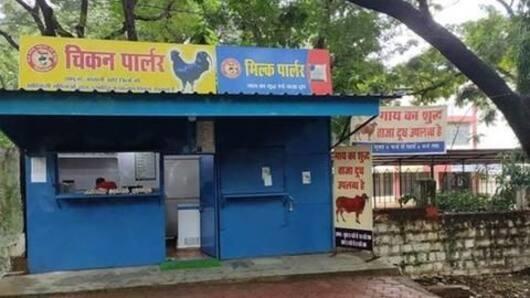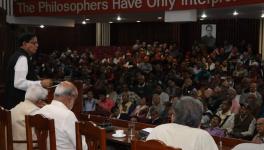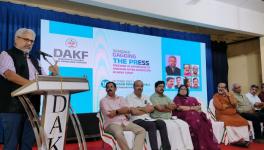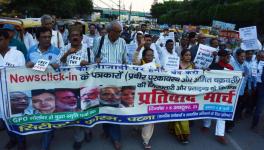A Chicken or Milk Situation for Indian Elite

Rameshwar Sharma, a Bharatiya Janata Party (BJP) legislator from Bhopal, recently said that chicken and cow milk should not be sold at the same stall, for it hurts Hindu religious sentiments. He was referring to a Madhya Pradesh government scheme that promote tribal producers of milk and chicken from one of the poorest districts of the country, Alirajpur.
According to Sharma, this scheme should separate the outlets that sell milk and chicken out of deference to Hindu sentiments, that is, to the presumed sentiments of vegetarians who would not drink milk purchased from an outlet which also sells eggs, chicken or meat.
Sharma is not alone. Not long ago, a Bengaluru-based lawyer filed a complaint against actor-politician Prakash Raj for saying, sarcastically, that cow dung and cow urine can be used to wash clothes. The lawyer claimed that this offended Hindu sentiments too.
These claims of hurt sentiments are not new. For long the issue of hurt religious feelings has been pitted against the constitutional right to freedom of speech and expression. The roots of such claims lie in India’s colonial past. That is why the flurry of such claims need to be dissected: Whose sentiment is hurt? How has hurt sentiment affected the judicial discourse of India, and, ultimately, who can assert that their sentiment is being hurt?
It would be anachronistic to claim that only the colonial past should shoulder the burden of repeatedly hurt sentiments in India. Yet, to put the entire burden on religion would also erase nuance from the issue. Therefore, to deconstruct hurt sentiment, it is necessary to look at where its roots are. For, it is the distant past that marked the onward journey of hurt sentiment, bringing it to this day when majoritarian feelings are offended even by milk being sold alongside chicken.
The Colonial Period and ‘Hurt Sentiments’
The British justified brutal censorship in India on grounds that “native people” are inherently sensitive to their religious feelings being provoked. They played with two tropes in order to stifle Indian voices. In both tropes, the justification came from the claim that the natives are acutely “sensitive”. The first trope was that modernisation was a colonial project. Put another way, the British defended their imperial reign by making the dubious claim that it was modernising India. The “easily offendable native” was a necessary construct to defend this claim.
Researcher Phillipp Sperner of the Ludwig-Maximilians-Universität Munich points out in a paper on Harmful Speech and the Politics of Hurt Sentiments ,published in the journal, Economic and Political Weekly, that “the trope of the easily offendable native provided a way for corroborating the importance of the civilising mission of the British empire and the inferiority of the Indian subjects vis-à-vis their masters”.
The protector’s role played by the British, to not let the public get affected by any outrageous expression, remains in place in today’s India. It is still deployed to curtail the freedom of speech and expression of Indian citizens.
The strategy is to float fear by presuming that a serious threat exists—the idea is for the State to behave as if anything and everything that smacks of dissent can outrage a certain community. In addition, the State pushes the presumption that anything that “hurts” sentiments can result in disorder. The third assumption is that a community is homogenous and can be represented by a handful of elites who assert “hurt sentiments” on behalf of all its other members.
In the 1920s, a series of cases in the high courts of Lahore and Allahabad revitalised the debate on hurt sentiment. In Raj Paul vs Emperor (1927), the Lahore High Court refused to prosecute an accused under Section 153A [promoting enmity] of the Indian Penal Code on the ground that an author had satirised Prophet Mohammad. The court said that the accused could not be held guilty as the provisions of 153A only cover the targeting of religions, not religious leaders.
However, in two other similar cases, Devi Sharan Sharma vs King Emperor (1927) and Kali Charan Sharma vs Emperor (1927), the Lahore and Allahabad High Courts held the publisher of material caricaturing Prophet Mohammad guilty of violating section 153A.
This judicial contradiction shows that instead of promoting freedom of speech and expression—which are considered integral to the British modernisation project—the colonial government enacted 295A of the IPC.
While drafting the IPC, British lawmakers were very cautious. They furthered the trope of ‘easily offendable native’ through this section by outlawing “deliberate and malicious acts intended to outrage religious feelings of any class by insulting its religion or religious feelings’. The addition of “religious feelings” strengthened the trope of “hurt sentiment” that severely affected discourse in post-Independence India.
Freedom of Speech and ‘Hurt Sentiments’
Legal scholar Siddharth Narrain, while looking into the relationship between hurt sentiments and freedom of speech in his paper, Hate Speech, Hurt Sentiment and the (Im)Possibility of Free Speech, talks of two prevalent strands of judicial thought in independent India.
The first is the strand of prioritising an ‘orderly sate’ over the claims of right to freedom of speech and expression. Defending the first amendment of Article 19(1) [freedom of speech and expression], India’s first Prime Minister Jawaharlal Nehru said, “How many of you remember, or have you forgotten, three and a half years ago, in this city of Delhi in the month of September 1947 in Punjab, in that entire body of western Pakistan, what happened? This Constitution was not there, but I am not thinking of the Constitution. Where was freedom anywhere—not constitutional freedom but the freedom of normal human impulses—where were those freedoms? Do you think any constitution will prevent me from dealing with such a situation? No. Otherwise the whole Constitution goes and the country goes.”
This statement explains the significance of maintenance of public order and justifies “reasonable restrictions” on freedom of speech. However, Nehru had faith that democratic institutions would be able to distinguish between speech that only criticises an order and speech with malicious intent that incites people into disturbing public order. Despite this, restrictions have repeatedly been imposed on artistic freedoms over the last seven decades in the name of ‘hurt sentiments’ and the assumed risk to public order.
In 1949, renowned cartoonist K Shankar Pillai drew a cartoon depicting the chairman of the Drafting Committee of the Constitution, Dr BR Ambedkar riding a snail. Pillai wanted to represent the slow pace of the Constituent Assembly’s debates that lasted almost three years. That cartoon was not controversial until 2006, when the National Council for Educational Research and Training (NCERT) included it in the history textbook. In 2012, the government withdrew all political cartoons from school texbooks in response to the controversy over the Ambedkar cartoon, whose ground was ‘hurt sentiment’, almost 60 years later.
True, the portrayal of Ambedkar may have hurt dalit sentiments (though even a section of dalit intellectuals classified it as an overreaction) but outright rejection still seems to have substituted constructive debate over the issue. Ambedkar himself was critical of the material released by the “Congress press” but never asked for compromise on the spirit of freedom of speech and expression.
The second strand of thought identified by Narrain stands on the claim of truth. While hearing N Veerabrahmam v State Of Andhra Pradesh, which relates to a “controversy around rationalist critique of the Bible and its putative insult to religion”, Justice Bhimasankaram came up with a dissenting judgment. The freedom of speech and expression does not provide an author the right to make “scurrilous attacks on the religion and religious beliefs of other sect with impunity”, the majority held.
Justice Bhimasankaran, however, held that he was “prepared to admit that conditions in India are different from those in other parts of the civilised world in regard to religious beliefs, and that there are classes of people in this country prone to fanaticism, bigotry and superstition. But all the same, we must not forget that we are in a secular state and cannot object to free-thinking... we must get used... to greater tolerance even of intolerance”.
Who has the Right to Say Their Sentiment is Hurt?
With time, India has enshrined ‘hurt sentiment’ and the presumed threats to community feelings are used regularly to mobilise vandals, be it the Hinduised masses who destroyed the Babri Masjid or a section of the Rajputs who declared a bounty on Hindi filmmaker, Sanjay Leela Bansali for his film Padmavaat.
The elite caste, upper class, religious majority and other privileged sections alone can proclaim themselves as representatives of their communities and don the role of conscience-keepers of the entire nation. It is they who float the notion of hurt sentiment. And it is they —the Rameshwar Sharmas—who would be at a loss if the Muslims of India launch protests over being hurt physically and otherwise. What if the dalits raise their legitimate rights over land and ask that their sentiments be respected? What if the eight million jailed within Kashmir and two million people excluded by the National Register of Citizens in Assam express their hurt sentiments? But the sanction of ‘hurt sentiment’ needs unrestrained privilege, absolute centralisation of power and majoritarian will, which these groups do not command.
Sara Ahmed, in her book, The Cultural Politics of Emotion claims that the majoritarian groups unite through common experiences of potential injury to produce a “unity of suffering”. She calls it “wound fetishism”, a concept relevant in our times. The Hindutva project is all about creating an atmosphere of fear where Hindu sentiment is “hurt”, “suffering” and “unnoticed”.
It is this claim that helps them unite against intellectual discussions; which makes even the screening of a documentary film or any progressive expression a threat rather than a right based on guaranteed freedom of speech. The Hinduised mob seeks to restrict fundamental rights and enlarge reasonable restrictions in the name of “threats to the nation” or “portraying the nation in bad light”, and, of course, “hurt sentiment”. Wound fetishism is their implicit mantra for survival.
When a privileged majority holds the logic of hurt sentiment aloft, its contradiction with freedom of speech need further exploration. In India, no distinction is drawn between acceptable speech and dangerous speech; nor is there any faith left in the institutions. Here, video-recorded lynching of a Muslim youth is turned into “cardiac arrest”.
In this context, it is our responsibility to reinterpret and understand what freedom of speech, hurt sentiments and reasonable restrictions mean in consonance with one another. This alone can restore faith that democratic institutions can safeguard public order. Otherwise, we will remain with colonial tropes of being “easily offendable natives” with forever-vulnerable sentiments.
Abhik is a Doctoral Research Fellow in School of Liberal Studies, Ambedkar University, Delhi. Views are personal.
Get the latest reports & analysis with people's perspective on Protests, movements & deep analytical videos, discussions of the current affairs in your Telegram app. Subscribe to NewsClick's Telegram channel & get Real-Time updates on stories, as they get published on our website.
























